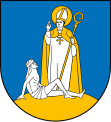Raba Wyżna
| Raba Wyżna | ||
|---|---|---|

|
|
|
| Basic data | ||
| State : | Poland | |
| Voivodeship : | Lesser Poland | |
| Powiat : | Nowotarski | |
| Gmina : | Raba Wyżna | |
| Geographic location : | 49 ° 35 ′ N , 19 ° 54 ′ E | |
| Residents : | 4116 (2007) | |
| Postal code : | 34-721 | |
| Telephone code : | (+48) 18 | |
| License plate : | KNT | |
| Economy and Transport | ||
| Street : | DK7 | |
| Rail route : | Chabówka – Zakopane | |
| Next international airport : | Krakow-Balice | |
Raba Wyżna is a village in the powiat Nowotarski of the Lesser Poland Voivodeship in Poland . It is the seat of the rural community of the same name with around 14,600 inhabitants.
The place is located about 55 kilometers south of Krakow and has 4116 inhabitants. The Raba flows through the village .
history
One of the first mentions of the village comes from tax registers ( Polish rejestry poborowe ) of the Kingdom of Poland from 1581.
In the years 1846–1847 the village suffered from famine as a result of poor harvests. Malnutrition and related diseases caused a third of the population to die. The insufficient supply of food and an inadequate hygienic infrastructure repeatedly led to outbreaks of dysentery, typhus and cholera in the 19th century. In September 1899 the railway line between Chabówka and Zakopane was opened. In 1902 the Głowiński Palace was built in the secession style in Raba Wyżna . The building is in need of renovation today. In 1906 the Raba Wyżna cooperative bank , which is still active today, was founded. On September 2, 1939, 40 houses were burned down as a result of a military conflict. More than 10 civilians lost their lives. Many residents then left the village. In 1941 the German military administration confiscated the church bells. From 1943 the palace was used by the occupiers. In 1945 the new communist rulers nationalized the palace and all of the property. In 1946 first steps were taken to rebuild the destroyed village. In 1957 the municipal administration building was erected. In 1961 the local department store (wiejski dom towarowy) opened and in 1965 the new school building was built. In 1985 the Głowiński Palace was listed as a historical monument. In 2000 a rehabilitation and care center was opened. In 2004 Lech Wałęsa opened the new road connection from Raba Wyżna to Harkabuz. Since 2004, the town center has been renovated and optically upgraded. The municipal administration has been renovated and the design language ties in with the Galician tradition of the place. Since 2004, funding from the European Union has also made it possible to implement various infrastructure projects such as transport infrastructure, sidewalks and sewerage.
local community
The rural community (gmina wiejska) Raba Wyżna includes eight villages with school boards :
Attractions
The Church of St. Stanislaus in Raba Wyżna was built in 1665 and expanded between 1841 and 1843. The ceiling paintings by Piotr Niziński (student of Jan Matejko ) from 1901 are remarkable .
Sports
The village has a soccer field and various sports facilities in the center. The school has a gym. The entire sports infrastructure has been rebuilt or extensively renovated in recent years.
The LKS "Orkan" Raba Wyżna football club was founded in 1946 and is the largest sports club in Raba Wyżna.
Personalities
The folk poet Wanda Czubernatowa and the sculptor Dawid Wędziarz work in the village.
- Stanisław Dziwisz (* 1939), cardinal, Archbishop of Kraków from 2005 to 2016 and former private secretary of Pope John Paul II.



